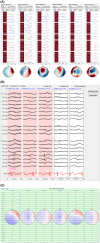Accurate identification of EEG recordings with interictal epileptiform discharges using a hybrid approach: Artificial intelligence supervised by human experts
- PMID: 35184276
- PMCID: PMC9148170
- DOI: 10.1111/epi.17206
Accurate identification of EEG recordings with interictal epileptiform discharges using a hybrid approach: Artificial intelligence supervised by human experts
Abstract
Objective: To evaluate the diagnostic performance of artificial intelligence (AI)-based algorithms for identifying the presence of interictal epileptiform discharges (IEDs) in routine (20-min) electroencephalography (EEG) recordings.
Methods: We evaluated two approaches: a fully automated one and a hybrid approach, where three human raters applied an operational IED definition to assess the automated detections grouped into clusters by the algorithms. We used three previously developed AI algorithms: Encevis, SpikeNet, and Persyst. The diagnostic gold standard (epilepsy or not) was derived from video-EEG recordings of patients' habitual clinical episodes. We compared the algorithms with the gold standard at the recording level (epileptic or not). The independent validation data set (not used for training) consisted of 20-min EEG recordings containing sharp transients (epileptiform or not) from 60 patients: 30 with epilepsy (with a total of 340 IEDs) and 30 with nonepileptic paroxysmal events. We compared sensitivity, specificity, overall accuracy, and the review time-burden of the fully automated and hybrid approaches, with the conventional visual assessment of the whole recordings, based solely on unrestricted expert opinion.
Results: For all three AI algorithms, the specificity of the fully automated approach was too low for clinical implementation (16.67%; 63.33%; 3.33%), despite the high sensitivity (96.67%; 66.67%; 100.00%). Using the hybrid approach significantly increased the specificity (93.33%; 96.67%; 96.67%) with good sensitivity (93.33%; 56.67%; 76.67%). The overall accuracy of the hybrid methods (93.33%; 76.67%; 86.67%) was similar to the conventional visual assessment of the whole recordings (83.33%; 95% confidence interval [CI]: 71.48-91.70%; p > .5), yet the time-burden of review was significantly lower (p < .001).
Significance: The hybrid approach, where human raters apply the operational IED criteria to automated detections of AI-based algorithms, has high specificity, good sensitivity, and overall accuracy similar to conventional EEG reading, with a significantly lower time-burden. The hybrid approach is accurate and suitable for clinical implementation.
Keywords: artificial intelligence; automated detection; convolutional neural networks; deep learning; hybrid method; interictal epileptiform EEG discharges.
© 2022 The Authors. Epilepsia published by Wiley Periodicals LLC on behalf of International League Against Epilepsy.
Conflict of interest statement
MBW is a co‐founder of Beacon Biosignals, which played no role in this work. FF and HP are employees of the AIT Austrian Institute of Technology, which owns all rights to the trademark Encevis and is the manufacturer of the software package Encevis. The remaining authors have no conflict of interest. We confirm that we have read the Journal's position on issues involved in ethical publication and affirm that this report is consistent with those guidelines.
Figures


References
-
- Tatum WO, Rubboli G, Kaplan PW, Mirsatari SM, Radhakrishnan K, Gloss D, et al. Clinical utility of EEG in diagnosing and monitoring epilepsy in adults. Clin Neurophysiol. 2018;129(5):1056–82. - PubMed
-
- Pillai J, Sperling MR. Interictal EEG and the diagnosis of epilepsy. Epilepsia. 2006;47(suppl 1):14–22. - PubMed
-
- da Silva LC, Tjepkema‐Cloostermans MC, van Putten MJAM. Machine learning for detection of interictal epileptiform discharges. Clin Neurophysiol. 2021;132(7):1433–43. - PubMed
-
- Beniczky S, Karoly P, Nurse E, Ryvlin P, Cook M. Machine learning and wearable devices of the future. Epilepsia. 2021;62(Suppl 2):S116–24. - PubMed
-
- Scherg M, Ille N, Weckesser D, Ebert A, Ostendorf A, Boppel T, et al. Fast evaluation of interictal spikes in long‐term EEG by hyper‐clustering. Epilepsia. 2012;53(7):1196–204. - PubMed

